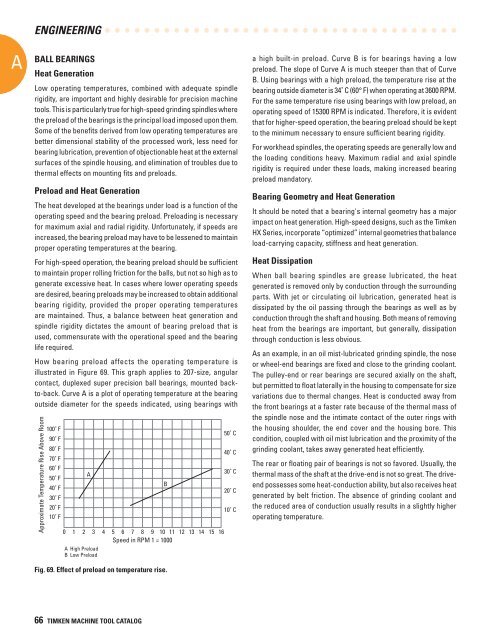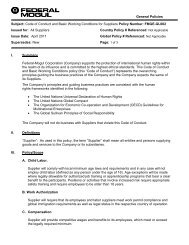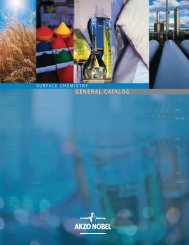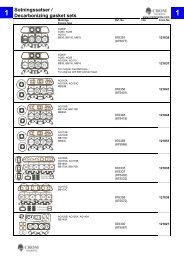You also want an ePaper? Increase the reach of your titles
YUMPU automatically turns print PDFs into web optimized ePapers that Google loves.
A<br />
ENGINEERING<br />
BALL BEARINGS<br />
Heat Generation<br />
Low operating temperatures, combined with adequate spindle<br />
rigidity, are important and highly desirable <strong>for</strong> precision machine<br />
tools. This is particularly true <strong>for</strong> high-speed grinding spindles where<br />
the preload of the bearings is the principal load imposed upon them.<br />
Some of the benefits derived from low operating temperatures are<br />
better dimensional stability of the processed work, less need <strong>for</strong><br />
bearing lubrication, prevention of objectionable heat at the external<br />
surfaces of the spindle housing, and elimination of troubles due to<br />
thermal effects on mounting fits and preloads.<br />
Preload and Heat Generation<br />
The heat developed at the bearings under load is a function of the<br />
operating speed and the bearing preload. Preloading is necessary<br />
<strong>for</strong> maximum axial and radial rigidity. Un<strong>for</strong>tunately, if speeds are<br />
increased, the bearing preload may have to be lessened to maintain<br />
proper operating temperatures at the bearing.<br />
For high-speed operation, the bearing preload should be sufficient<br />
to maintain proper rolling friction <strong>for</strong> the balls, but not so high as to<br />
generate excessive heat. In cases where lower operating speeds<br />
are desired, bearing preloads may be increased to obtain additional<br />
bearing rigidity, provided the proper operating temperatures<br />
are maintained. Thus, a balance between heat generation and<br />
spindle rigidity dictates the amount of bearing preload that is<br />
used, commensurate with the operational speed and the bearing<br />
life required.<br />
How bearing preload affects the operating temperature is<br />
illustrated in Figure 69. This graph applies to 207-size, angular<br />
contact, duplexed super precision ball bearings, mounted backto-back.<br />
Curve A is a plot of operating temperature at the bearing<br />
outside diameter <strong>for</strong> the speeds indicated, using bearings with<br />
Approximate Temperature Rise Above Room<br />
100˚ F<br />
90˚ F<br />
80˚ F<br />
70˚ F<br />
60˚ F<br />
50˚ F<br />
40˚ F<br />
30˚ F<br />
20˚ F<br />
10˚ F<br />
0<br />
A<br />
1 2 3 4 5 6 7 8 9 10 11 12 13 14 15 16<br />
Speed in RPM 1 = 1000<br />
A High Preload<br />
B Low Preload<br />
Fig. 69. Effect of preload on temperature rise.<br />
B<br />
50˚ C<br />
40˚ C<br />
30˚ C<br />
20˚ C<br />
10˚ C<br />
a high built-in preload. Curve B is <strong>for</strong> bearings having a low<br />
preload. The slope of Curve A is much steeper than that of Curve<br />
B. Using bearings with a high preload, the temperature rise at the<br />
bearing outside diameter is 34˚ C (60° F) when operating at 3600 RPM.<br />
For the same temperature rise using bearings with low preload, an<br />
operating speed of 15300 RPM is indicated. There<strong>for</strong>e, it is evident<br />
that <strong>for</strong> higher-speed operation, the bearing preload should be kept<br />
to the minimum necessary to ensure sufficient bearing rigidity.<br />
For workhead spindles, the operating speeds are generally low and<br />
the loading conditions heavy. Maximum radial and axial spindle<br />
rigidity is required under these loads, making increased bearing<br />
preload mandatory.<br />
Bearing Geometry and Heat Generation<br />
It should be noted that a bearing's internal geometry has a major<br />
impact on heat generation. High-speed designs, such as the <strong>Timken</strong><br />
HX Series, incorporate “optimized” internal geometries that balance<br />
load-carrying capacity, stiffness and heat generation.<br />
Heat Dissipation<br />
When ball bearing spindles are grease lubricated, the heat<br />
generated is removed only by conduction through the surrounding<br />
parts. With jet or circulating oil lubrication, generated heat is<br />
dissipated by the oil passing through the bearings as well as by<br />
conduction through the shaft and housing. Both means of removing<br />
heat from the bearings are important, but generally, dissipation<br />
through conduction is less obvious.<br />
As an example, in an oil mist-lubricated grinding spindle, the nose<br />
or wheel-end bearings are fixed and close to the grinding coolant.<br />
The pulley-end or rear bearings are secured axially on the shaft,<br />
but permitted to float laterally in the housing to compensate <strong>for</strong> size<br />
variations due to thermal changes. Heat is conducted away from<br />
the front bearings at a faster rate because of the thermal mass of<br />
the spindle nose and the intimate contact of the outer rings with<br />
the housing shoulder, the end cover and the housing bore. This<br />
condition, coupled with oil mist lubrication and the proximity of the<br />
grinding coolant, takes away generated heat efficiently.<br />
The rear or floating pair of bearings is not so favored. Usually, the<br />
thermal mass of the shaft at the drive-end is not so great. The driveend<br />
possesses some heat-conduction ability, but also receives heat<br />
generated by belt friction. The absence of grinding coolant and<br />
the reduced area of conduction usually results in a slightly higher<br />
operating temperature.<br />
66 TIMKEN MACHINE TOOL CATALOG







